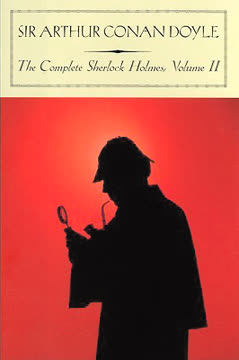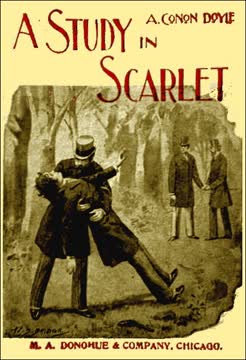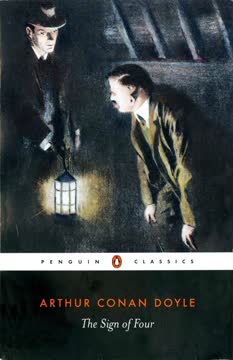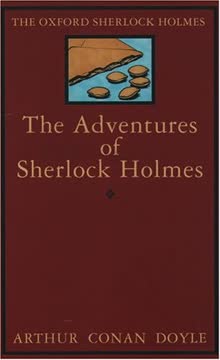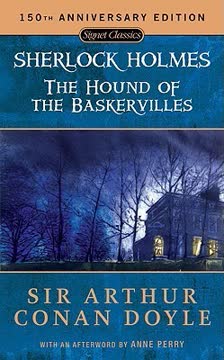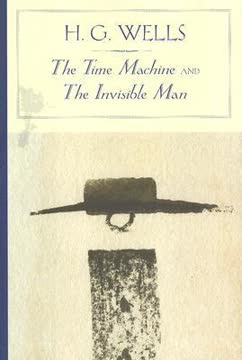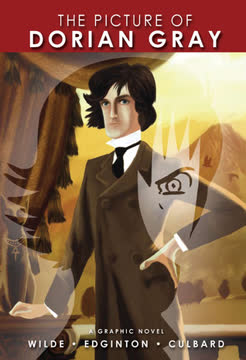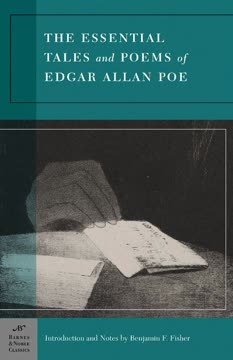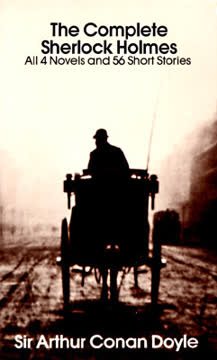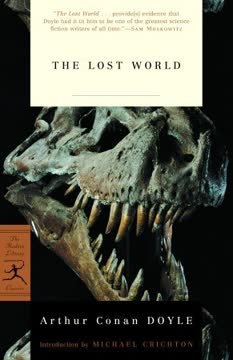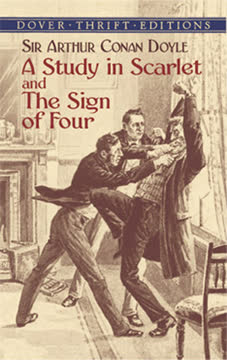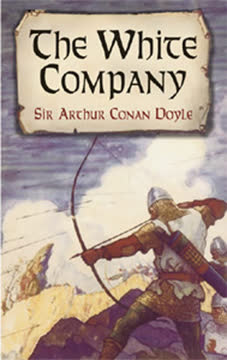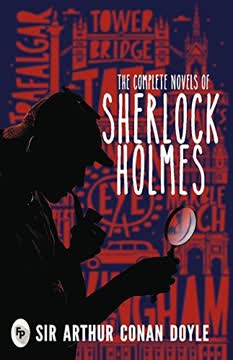Plot Summary
1. A Flatmate and a New Science
Dr. John Watson, a war-weary physician, returns to London and meets the enigmatic Sherlock Holmes, whose eccentricities and brilliance are immediately apparent. Sharing rooms at 221B Baker Street, Watson is drawn into Holmes's world of deduction and scientific crime-solving. Holmes's profession as a "consulting detective" is a novelty, and Watson's curiosity is piqued by Holmes's unique methods and disregard for social conventions. Their partnership is born out of mutual respect and fascination, setting the stage for a series of adventures that will test the limits of logic, friendship, and the human psyche.
2. The Art of Deduction
Holmes demonstrates his extraordinary powers of deduction, reading people and situations from the smallest details—mud on shoes, ink stains, or a handshake. He explains his method: observe everything, eliminate the impossible, and whatever remains, however improbable, must be the truth. Watson, both skeptical and amazed, becomes the chronicler of Holmes's cases, providing a human perspective to Holmes's almost superhuman intellect. This chapter establishes the intellectual foundation of the stories and the dynamic between the two men.
3. Scarlet Murders and American Vengeance
Holmes and Watson are called to investigate a mysterious murder at Lauriston Gardens, where a corpse, a cryptic word in blood, and a woman's ring are the only clues. Holmes's investigation uncovers a tale rooted in the American West, involving Mormons, lost love, and a relentless quest for vengeance. The killer, Jefferson Hope, is driven by obsession and justice, and Holmes's unraveling of the case showcases his ability to connect seemingly unrelated clues across continents and years. The story explores the enduring impact of the past and the complexities of justice.
4. London's Fog and Holmes's Fame
As Holmes's fame spreads, he is sought out by clients and rivals alike, including the skeptical Scotland Yard detectives Gregson and Lestrade. Holmes's "science of deduction" is tested in a variety of cases, from missing jewels to blackmail, and Watson documents both triumphs and failures. The partnership between Holmes and Watson deepens, and the foggy streets of London become the backdrop for their intellectual pursuits and the ongoing tension between officialdom and unconventional genius.
5. The Sign of the Four: Treasure and Betrayal
Mary Morstan seeks Holmes's help in finding her missing father and a mysterious treasure. The investigation leads to a secret pact among four convicts in India, betrayal, and a series of murders. Holmes's deductive skills are matched by the cunning of Jonathan Small, whose tale of loss and revenge adds emotional depth. Watson finds love with Mary, while Holmes remains devoted to his work, highlighting the contrast between personal fulfillment and professional obsession.
6. Ciphers, Secrets, and Tragedy
Holmes is consulted on cases involving secret codes, such as the dancing men, which threaten to unravel lives. Despite Holmes's brilliance in deciphering messages and uncovering threats from the past, tragedy sometimes strikes, as in the case of Hilton Cubitt and his wife. These stories emphasize the power of secrets, the limits of even the greatest detective, and the emotional toll of unresolved histories.
7. The Woman Who Outsmarted Holmes
Holmes is hired to recover a compromising photograph from Irene Adler, a woman of wit and resourcefulness. Through disguise and cunning, Holmes locates the photograph, only to be outmaneuvered by Adler, who escapes with her new husband. Holmes's admiration for her intellect and independence is lasting, and she becomes "the woman" in his life—a symbol of the limits of his own abilities and the power of agency.
8. The Red-Headed League's Ruse
A red-haired pawnbroker is lured into a fake "Red-Headed League" to distract him while criminals tunnel into a bank. Holmes sees through the ruse, sets a trap, and captures the mastermind, John Clay. The case is a classic example of Holmes's ability to discern patterns and his delight in the theatrical aspects of detection, illustrating the interplay between deception and revelation.
9. Disguises and Vanishing Bridegrooms
Holmes investigates the disappearance of a bridegroom on his wedding day, uncovering a plot by the bride's stepfather to prevent her marriage and retain control of her inheritance. Through analysis of typewritten letters and clever questioning, Holmes exposes the stepfather's disguise and motives. The case explores themes of greed, manipulation, and the vulnerability of women in Victorian society.
10. The Final Problem: Holmes and Moriarty
Holmes confronts Professor Moriarty, the "Napoleon of crime," whose criminal network threatens to engulf London. Pursued across Europe, Holmes and Watson are drawn into a deadly game that culminates at the Reichenbach Falls. In a final confrontation, Holmes and Moriarty vanish over the precipice, leaving Watson—and the world—in mourning. The story marks a turning point, exploring the costs of obsession and the nature of true genius.
11. Black Peter and the Harpooner's Past
Holmes and Watson investigate the savage killing of "Black Peter" Carey, a retired whaling captain. The case is a web of old grudges, missing securities, and a mysterious visitor. Holmes's attention to physical details and human nature uncovers the real killer, Patrick Cairns, whose violent past and desperation drive the crime. The story highlights the long reach of the past and the detective's ability to see through bravado to the wounded soul beneath.
12. The King of Blackmail Unmasked
Holmes is drawn into the world of Charles Augustus Milverton, London's most notorious blackmailer. Hired to recover compromising letters, Holmes and Watson resort to burglary, only to witness Milverton's murder by a woman he ruined. Holmes's moral code is tested as he withholds evidence, recognizing that the law cannot always deliver true justice. The episode explores the gray areas between right and wrong and the power of secrets.
13. Obsession, Pearls, and Broken Busts
A series of bust-smashings leads Holmes to the theft of the legendary black pearl of the Borgias. The criminal, Beppo, hides the pearl in a plaster bust, triggering a trail of destruction and murder. Holmes's patient tracing of clues and understanding of criminal psychology culminate in the recovery of the pearl and the unmasking of the murderer. The case is a study in obsession and the detective's ability to see the pattern beneath apparent madness.
14. Academic Temptations and Redemption
Holmes is called to a university town to solve the theft of an exam proof. Three students are suspects, each with motive and opportunity. Through subtle observation, Holmes uncovers the truth: Gilchrist, a promising athlete, succumbed to temptation but is redeemed by the loyalty of his old servant. The story explores the pressures of ambition, the pain of guilt, and the possibility of redemption.
15. Fatal Secrets and Golden Pince-Nez
A secretary is found dead, a pair of golden pince-nez the only clue. Holmes's analysis leads to a hidden woman, the scholar's estranged wife, driven by revolutionary passions and old betrayals. The case is a meditation on exile, justice, and the tragic costs of political idealism, as Holmes's empathy and scientific rigor bring closure to a story of love, loss, and revenge.
16. Love, Loss, and the Missing Three-Quarter
On the eve of a crucial rugby match, star player Godfrey Staunton vanishes. Holmes's investigation uncovers a secret marriage and a dying wife, hidden from a wealthy, controlling uncle. The case is a poignant study of love's sacrifices, the burdens of secrecy, and the limits of social convention. Holmes's compassion and discretion ensure that private grief is shielded from public scandal.
17. Domestic Crimes and Staged Scenes
Lady Brackenstall's husband is found murdered, apparently by burglars. Holmes's skepticism and attention to physical evidence reveal a staged scene. The true story is one of domestic abuse, a desperate struggle, and a lover's intervention. Holmes's sense of justice leads him to shield the guilty from the law, recognizing the moral complexity of the case and the need for mercy.
18. Espionage, State Secrets, and Sacrifice
On the eve of World War I, Holmes comes out of retirement to unmask Von Bork, a German master spy. Through disguise, patience, and psychological insight, Holmes secures vital secrets for England. The story is a meditation on patriotism, the changing world, and the detective's willingness to risk all for a greater good. Holmes's final bow is both an end and a beginning, as the old world gives way to the new.
Characters
Sherlock Holmes
Holmes is the embodiment of rationality, observation, and deduction, yet his character is far from one-dimensional. He is driven by a need for intellectual stimulation and justice, often at the expense of personal comfort or social norms. Holmes's emotional detachment is both his strength and his Achilles' heel, allowing him to solve cases others cannot but sometimes leaving him isolated. His relationship with Watson is the anchor of his life, providing both companionship and a sounding board for his ideas. Over time, Holmes's empathy and moral ambiguity deepen, as he confronts the limits of the law and the complexities of human nature.
Dr. John H. Watson
Watson is Holmes's confidant, assistant, and the narrator of most stories. His bravery, compassion, and grounded nature provide a human counterpoint to Holmes's brilliance. Watson's journey—from wounded veteran to happily married man—mirrors the search for meaning and connection in a world of uncertainty. He is the reader's surrogate, expressing the emotions Holmes suppresses and asking the questions we would ask. Watson's vulnerabilities and strengths make him an essential bridge between Holmes and the world.
Irene Adler
Adler is the only person to outwit Holmes, earning his lasting respect. Her intelligence, resourcefulness, and decisiveness challenge Victorian gender norms and show that agency and intellect are not confined to men. Adler's story is a testament to the power of wit and the importance of self-determination.
Professor Moriarty
Moriarty is Holmes's intellectual equal and moral opposite, orchestrating crimes from the shadows. His cold calculation and ambition make him a formidable foe, pushing Holmes to his limits and forcing him to confront the darkness at the heart of human nature. Moriarty's presence elevates the stakes and provides a larger narrative arc.
Charles Augustus Milverton
Milverton wields secrets as weapons, delighting in the suffering of others. His murder by a wronged woman and Holmes's complicity in concealing the truth raise questions about the limits of law and the nature of justice. Milverton embodies the dangers of unchecked power and the moral ambiguities of retribution.
Patrick Cairns
Cairns is both perpetrator and victim, shaped by hardship and desperation. His confession and capture reveal Holmes's ability to see through bravado to the wounded soul beneath, highlighting the long reach of the past and the complexities of justice.
Lady Brackenstall
Lady Brackenstall's courage in the face of violence and her willingness to risk all for love make her a complex and sympathetic figure. Her story challenges Victorian notions of femininity, morality, and justice, emphasizing the need for compassion and understanding.
Mary Morstan
Mary is the client who becomes Watson's wife. Her calm under pressure, loyalty, and openness to love despite hardship make her a symbol of resilience. Mary's presence brings warmth and stability to Watson's life, highlighting the importance of personal connection.
Baron Gruner
Gruner is a master manipulator whose surface charm conceals a monstrous heart. His downfall is engineered by Holmes's cunning and the courage of his victims, making him a symbol of evil undone by its own arrogance.
John Clay
Clay's elaborate schemes and flair for deception make him a memorable adversary. His capture in the Red-Headed League case showcases Holmes's ability to see through ruses and his delight in the theatrical aspects of detection.
Plot Devices
The Science of Deduction
Holmes's method is the central plot device, gathering minute details, discarding irrelevancies, and building a chain of reasoning that leads to the truth. This approach is both a narrative structure and a philosophical stance, emphasizing rationality in a chaotic world. The stories often hinge on Holmes's ability to see what others miss, turning the ordinary into the extraordinary.
Disguise and Deception
Holmes and his adversaries frequently use disguise to gather information or evade detection. This device allows for dramatic reveals and tests the limits of perception and trust. Disguise also serves as a metaphor for the hidden aspects of human nature and the difficulty of discerning truth.
Codes and Ciphers
From the dancing men to cryptic letters, codes are used to conceal and reveal secrets. Holmes's skill at deciphering them underscores the importance of communication and the dangers of misunderstanding. Codes also symbolize the barriers between people—emotional, cultural, or psychological—that must be overcome to achieve understanding.
The Past Haunting the Present
Many cases are rooted in events years or continents away, showing how unresolved trauma and hidden histories shape current actions. This device adds depth to the mysteries and highlights the interconnectedness of human lives.
The Rivalry with Officialdom
The tension between Holmes and the official detectives provides both conflict and comic relief. It also raises questions about authority, expertise, and the value of unconventional thinking.
The Mastermind Antagonist
The introduction of a criminal mastermind elevates the stakes and gives Holmes a worthy opponent. Moriarty's presence creates a sense of ongoing danger and a larger narrative arc, culminating in the apparent death of Holmes.
The Unreliable Narrator
Watson's narration shapes the reader's experience, filtering events through his admiration, doubts, and occasional misunderstandings. This device allows for suspense, surprise, and the gradual revelation of Holmes's methods.
The False Alibi
Many cases hinge on the construction and deconstruction of alibis—whether it's a forged theater ticket, a staged burglary, or a manipulated timeline. Holmes's genius lies in his ability to see through the surface to the reality beneath, using physical evidence, psychological insight, and logical rigor to expose the truth.
The Hidden Document
From missing diplomatic letters to incriminating diaries, documents are both weapons and shields. Their concealment, discovery, and interpretation drive the plots and reveal the stakes of knowledge in a world of shifting loyalties.
The Exotic Threat
Foreign and scientific dangers challenge Holmes's rationalism and force him to confront the limits of knowledge. These threats are both literal and symbolic, representing the anxieties of a changing world.
The Moral Dilemma
Many stories confront Holmes—and the reader—with questions of right and wrong that cannot be resolved by logic alone. Whether it's concealing a crime, protecting the innocent, or allowing a killer to go free, Holmes's choices reveal a complex, evolving moral philosophy that balances justice with compassion.
Analysis
The Complete Sherlock Holmes: Volume II is a masterwork of detective fiction, blending intricate puzzles with deep psychological and moral insight. Holmes's methods—rooted in observation, deduction, and scientific reasoning—offer a reassuring order in a world of uncertainty, yet the stories also probe the limits of logic and the unpredictability of human nature. The recurring themes—disguise, code, rivalry, revenge, and the haunting power of the past—reflect the complexities of identity and the dangers of secrets. Holmes himself is both a symbol of rationality and a figure of loneliness, his brilliance isolating him even as it saves others. Through Watson's eyes, we see not only the triumphs of reason but also the costs of obsession, the pain of loss, and the need for connection. The stories endure because they balance the thrill of the chase with the poignancy of the human condition, inviting readers to marvel at the mind of Sherlock Holmes while recognizing the mysteries that lie within us all.
Last updated:
FAQ
Synopsis & Basic Details
What is The Complete Sherlock Holmes: Volume II about?
- A Collection of Mysteries: This volume compiles a significant portion of Sherlock Holmes's adventures, including two full-length novels, The Sign of the Four and The Hound of the Baskervilles, alongside numerous short stories from The Adventures of Sherlock Holmes, The Memoirs of Sherlock Holmes, The Return of Sherlock Holmes, His Last Bow, and The Case-Book of Sherlock Holmes. It showcases Holmes's evolution as a detective and his enduring partnership with Dr. Watson.
- Diverse Criminal Landscape: The narratives span a wide array of criminal activities, from intricate blackmail schemes and international espionage to brutal murders driven by vengeance, greed, or twisted love. Each story presents a unique puzzle, challenging Holmes's deductive prowess and often revealing the darker undercurrents of Victorian society.
- Character and Method Development: Beyond the crimes, the collection delves into the characters of Sherlock Holmes and Dr. Watson, exploring their unique dynamic, Holmes's intellectual brilliance and eccentricities, and Watson's role as chronicler and moral compass. It highlights Holmes's "science of deduction" and his encounters with memorable antagonists, including his arch-nemesis, Professor Moriarty.
Why should I read The Complete Sherlock Holmes: Volume II?
- Masterclass in Deduction: Readers should delve into this volume to witness Arthur Conan Doyle's unparalleled mastery of detective fiction. Each case is a meticulously crafted puzzle, offering a thrilling intellectual exercise as Holmes unravels complex mysteries using observation, logic, and scientific method.
- Rich Character Exploration: Beyond the plots, the collection offers profound insights into the human condition, exploring themes of justice, morality, obsession, and the enduring impact of the past. The evolving relationship between Holmes and Watson provides a compelling emotional core, making the stories resonate on a deeper level.
- Historical and Cultural Immersion: The stories provide a vivid snapshot of late Victorian and early Edwardian England, from the foggy streets of London to the desolate moors of Dartmoor. Doyle subtly weaves in contemporary social anxieties, technological advancements, and cultural references, offering a rich historical tapestry for readers to explore.
What is the background of The Complete Sherlock Holmes: Volume II?
- Victorian and Edwardian Context: The stories are set against the backdrop of late 19th and early 20th-century Britain, a period of rapid industrialization, social change, and imperial expansion. This era's anxieties, such as the rise of organized crime, the impact of foreign influences, and the rigid class structure, often form the thematic undercurrents of Holmes's cases.
- Scientific and Philosophical Underpinnings: Arthur Conan Doyle, a trained physician, infused his narratives with a strong emphasis on scientific method, forensic science (then in its infancy), and rational thought. Holmes's reliance on empirical evidence and logical deduction reflects the scientific optimism of the age, even as the stories occasionally touch upon the supernatural or the inexplicable.
- Literary Evolution: This volume showcases Doyle's development as a writer, moving from the earlier, more straightforward mysteries to increasingly complex narratives that explore psychological depth and moral ambiguity. The introduction of Professor Moriarty, for instance, reflects a desire to challenge Holmes with an intellectual equal, pushing the boundaries of the detective genre.
What are the most memorable quotes in The Complete Sherlock Holmes: Volume II?
- "When you have eliminated the impossible, whatever remains, however improbable, must be the truth.": This iconic quote, frequently reiterated by Holmes, encapsulates his core deductive philosophy. It appears notably in The Sign of the Four and The Blanched Soldier, serving as a guiding principle for his investigations and a challenge to Watson's more conventional thinking.
- "Data! data! data! I can't make bricks without clay.": From The Adventure of the Copper Beeches, this exclamation highlights Holmes's absolute reliance on facts and evidence. It underscores his scientific approach, emphasizing that even his brilliant deductions require a solid foundation of observed details, no matter how seemingly trivial.
- "The world is full of obvious things which nobody by any chance ever observes.": Spoken in The Hound of the Baskervilles, this quote perfectly illustrates Holmes's unique gift. It points to the pervasive human tendency to overlook the small, significant details that, to a trained eye, reveal the entire truth, distinguishing Holmes's perceptive genius from ordinary perception.
What writing style, narrative choices, and literary techniques does Arthur Conan Doyle use?
- First-Person Narrative (Watson's Perspective): The majority of the stories are narrated by Dr. Watson, providing a human, often awestruck, perspective on Holmes's genius. This choice allows for suspense, as Watson (and thus the reader) is often a step behind Holmes, and it highlights Holmes's deductions through the lens of an admiring, yet sometimes bewildered, friend.
- Emphasis on Rationalism and Empiricism: Doyle consistently employs a scientific approach to crime-solving, with Holmes meticulously observing details, collecting evidence, and applying logical reasoning. This is evident in his detailed descriptions of footprints, tobacco ash, or chemical reactions, grounding the fantastical plots in a veneer of scientific credibility.
- Dramatic Structure and Foreshadowing: Doyle masterfully builds suspense through careful pacing, dramatic reveals, and subtle foreshadowing. Seemingly minor details or casual remarks often gain immense significance later in the narrative, creating a sense of inevitability and intellectual satisfaction when Holmes finally unveils the solution.
Hidden Details & Subtle Connections
What are some minor details that add significant meaning?
- The "Jezail bullet" in Watson's leg: Mentioned in A Study in Scarlet and The Sign of the Four, this recurring detail is more than just a war wound. It symbolizes Watson's past trauma and vulnerability, contrasting with Holmes's intellectual detachment. It also subtly explains Watson's occasional lameness or discomfort, grounding his character in physical reality and reminding the reader of his military background.
- Holmes's violin playing: Often described as a means for Holmes to "introspect" or "soothe his ruffled spirits" (The Red-Headed League, The Five Orange Pips), his violin is not just a hobby. It symbolizes his need for intellectual and emotional release, a counterpoint to the rigid logic of his work. The music often reflects his mental state, from melancholy brooding to triumphant exultation, offering a rare glimpse into his inner world.
- The specific brands of tobacco and cigar ashes: In cases like The Sign of the Four and The Boscombe Valley Mystery, Holmes's ability to identify specific tobacco ashes (e.g., "Trichinopoly") is a seemingly trivial detail that proves crucial. It highlights his encyclopedic, specialized knowledge and his belief that "to a great mind, nothing is little," demonstrating how minutiae can unlock major mysteries.
What are some subtle foreshadowing and callbacks?
- The "Book of Life" article in A Study in Scarlet: Early in the first novel, Watson reads an article written by Holmes himself, outlining his theories of deduction. This not only introduces Holmes's methods but also subtly foreshadows the entire narrative structure of the series, where Holmes will indeed infer vast truths from single "links" of evidence.
- The recurring mention of "The Woman" (Irene Adler): After A Scandal in Bohemia, Irene Adler is occasionally referenced by Holmes, always with a unique reverence. This subtle callback reinforces her singular impact on Holmes, reminding the reader that even the "calculating machine" has encountered a force that defied his logic and earned his lasting respect.
- The "Valley of Fear" phrase: In The Valley of Fear, Mrs. Douglas's repeated, fearful utterance of "The Valley of Fear" foreshadows the entire second part of the novel, which delves into the brutal history of the Vermissa Valley. This phrase acts as a thematic anchor, linking the present crime to a deep-seated, violent past.
What are some unexpected character connections?
- Colonel Emsworth and Godfrey Emsworth in The Blanched Soldier: The initial portrayal of Colonel Emsworth as a harsh, unyielding father who has sent his son away is later revealed to be a desperate act of protection. The unexpected connection is the father's profound love and sacrifice, concealing his son's pseudo-leprosy to save him from social ostracization, challenging initial assumptions about his character.
- The shared past of John Ferrier and Joseph Stangerson in A Study in Scarlet: The revelation that the murder victim, Enoch Drebber, and his secretary, Joseph Stangerson, were both connected to John Ferrier and the Mormon community in Utah is a profound and unexpected link. It transforms a seemingly random London murder into a long-simmering tale of revenge, highlighting the deep, hidden connections forged by shared history and trauma.
- The dual identity of James Windibank/Hosmer Angel in A Case of Identity: The shocking discovery that the charming suitor, Hosmer Angel, is actually the manipulative stepfather, James Windibank, reveals an unexpected and disturbing connection. This twist exposes the depths of deception within a family and the lengths to which an individual will go to control another's life and finances.
Who are the most significant supporting characters?
- Mycroft Holmes: Sherlock's elder brother, introduced in The Greek Interpreter and playing a crucial role in The Bruce-Partington Plans, is significant as the only character whose intellect Holmes admits surpasses his own. Mycroft's unique position as a "human clearing-house" for government information, coupled with his extreme indolence, provides a fascinating contrast to Sherlock and highlights the different ways genius can manifest.
- Inspector Stanley Hopkins: A recurring Scotland Yard detective, particularly prominent in The Adventure of the Golden Pince-Nez and The Adventure of Black Peter, Hopkins represents the younger generation of police officers whom Holmes attempts to mentor. His earnestness and willingness to learn, despite his initial conventionality, make him a sympathetic figure and a foil for Holmes's more advanced methods.
- Mrs. Hudson: Though often a background figure, Mrs. Hudson, the landlady of 221B Baker Street, is a constant presence. Her "long-suffering" nature, tolerance of Holmes's eccentricities, and occasional moments of concern (as in The Dying Detective) provide a domestic anchor and a subtle emotional warmth to Holmes's otherwise austere existence. She represents the quiet, enduring support system that enables Holmes's work.
Psychological, Emotional, & Relational Analysis
What are some unspoken motivations of the characters?
- Holmes's pursuit of intellectual stimulation: Beyond justice, Holmes is driven by an insatiable need to exercise his "brain-attic." His frequent use of cocaine (mentioned in The Sign of the Four) during periods of inactivity reveals a deep-seated psychological need for mental engagement, suggesting that the thrill of the chase is as vital to him as the resolution of the crime.
- Dr. Watson's need for purpose and adventure: Watson's initial state as a "war-weary physician" in A Study in Scarlet, suffering from a "comfortless, meaningless existence," reveals his unspoken motivation for joining Holmes. The adventures provide him with a renewed sense of purpose, excitement, and a profound friendship that fills the void left by his military career and personal losses.
- Lady Hilda Trelawney Hope's desperate secrecy in The Second Stain: Lady Hilda's frantic efforts to conceal her involvement in the theft of the naval treaty are driven by a deep-seated fear of public scandal and the ruin of her husband's career. Her unspoken motivation is a complex mix of love, loyalty, and a desperate desire to protect her social standing, even at the cost of further deception.
What psychological complexities do the characters exhibit?
- The duality of Sherlock Holmes: Holmes often exhibits a profound psychological complexity, oscillating between intense intellectual focus and periods of deep lethargy or drug use. His "cold, precise but admirably balanced mind" (A Scandal in Bohemia) is a carefully constructed facade, beneath which lies a sensitive, almost artistic temperament, capable of deep empathy (as seen in The Illustrious Client) but often suppressed for the sake of pure reason.
- The internal conflict of John Ferrier in A Study in Scarlet: Ferrier's decision to remain celibate in a polygamous Mormon society, despite the social pressure, reveals a deep psychological commitment to his past love and his adopted daughter, Lucy. His internal struggle between conforming to the community and adhering to his personal moral code highlights the psychological toll of living under oppressive religious dogma.
- The "twisted" psyche of Charles Augustus Milverton: Milverton's delight in blackmail, described as torturing souls "methodically and at his leisure" (The Illustrious Client), showcases a chilling psychological profile. His motivation is not merely financial but a perverse enjoyment of power and control over others' reputations, revealing a deep-seated sadism that makes him one of Holmes's most repulsive adversaries.
What are the major emotional turning points?
- Watson's decision to marry Mary Morstan in The Sign of the Four: This is a significant emotional turning point for Watson, marking his embrace of personal happiness and a life beyond constant adventure. His internal debate about whether his "half-pay surgeon" status makes him a "fortune-seeker" reveals his deep emotional integrity and the profound impact Mary has on his sense of self-worth.
- Holmes's "death" at Reichenbach Falls in The Final Problem: This event is a monumental emotional turning point, not just for Watson, who experiences "joy, amazement, and incredulity" upon Holmes's return in The Empty House, but also for Holmes himself. His decision to fake his death, driven by the necessity of dismantling Moriarty's network, forces him into a period of profound isolation and self-reflection, altering his perspective on life and his work.
- Lady Brackenstall's transformation in The Adventure of Shoscombe Old Place: The revelation that Lady Beatrice is dead and being impersonated by her maid, and the subsequent discovery of her brother's desperate scheme, marks an emotional turning point for the reader. It transforms the initial mystery into a poignant tale of a woman's suffering and a brother's misguided, desperate loyalty, evoking sympathy despite the criminal acts.
How do relationship dynamics evolve?
- Holmes and Watson's deepening bond: Throughout the volume, their relationship evolves from a professional arrangement to a profound friendship. Watson's unwavering loyalty and Holmes's increasing (though often unspoken) reliance on Watson's presence and moral grounding are evident. Moments like Holmes's "thousand apologies" for startling Watson with his return (The Empty House) or his rare expressions of affection (The Three Garridebs) highlight the depth of their connection.
- The destructive nature of the Douglas-Barker-Mrs. Douglas triangle in The Valley of Fear: The initial impression of a loving couple and a loyal friend is shattered by the revelation of a complex web of deception, past trauma, and a staged murder. The relationship dynamics are revealed to be built on secrets and fear, ultimately leading to tragedy and the unraveling of their carefully constructed lives.
- The manipulative control in the Rucastle household in The Copper Beeches: The relationship between Mr. Rucastle and his stepdaughter, Violet Hunter, and the hidden imprisonment of his own daughter, Alice, showcases a deeply dysfunctional and controlling dynamic. Rucastle's manipulation of his wife and servants, driven by greed, highlights the insidious ways power can corrupt family relationships.
Interpretation & Debate
Which parts of the story remain ambiguous or open-ended?
- The ultimate fate of the "Lion's Mane" creature: In The Adventure of the Lion's Mane, while Holmes identifies the deadly jellyfish (Cyanea capillata) as the cause of death, the exact circumstances of its arrival and its continued presence in the bathing pool remain somewhat ambiguous. Was it a natural occurrence, or was it deliberately introduced or cultivated by someone with malicious intent? The story leaves room for debate on the extent of human agency versus natural forces in the tragedy.
- The true nature of Professor Moriarty's network: Despite Holmes's detailed description of Moriarty as the "Napoleon of crime" and the "controlling brain of the underworld" in The Final Problem, the full extent and inner workings of his organization remain largely unseen and unexplained. This ambiguity allows Moriarty to exist as a formidable, almost mythical, antagonist, but it also leaves readers to ponder the true scope of his influence and whether Holmes's portrayal is entirely objective or partly colored by his own obsession.
- The long-term psychological impact on survivors: Many cases conclude with the resolution of the crime, but the lasting psychological effects on characters like Miss Helen Stoner (The Speckled Band), Mrs. Douglas (The Valley of Fear), or Miss Violet Hunter (The Copper Beeches) are often left open-ended. While Holmes provides justice, the narratives rarely delve into the full emotional recovery or the long-term consequences of their traumatic experiences, inviting readers to contemplate the enduring scars of crime.
What are some debatable, controversial scenes or moments in The Complete Sherlock Holmes: Volume II?
- Holmes's complicity in Milverton's murder in The Adventure of Charles Augustus Milverton: This is arguably one of the most morally ambiguous moments in the entire canon. Holmes and Watson break into Milverton's house, only to witness his murder by a wronged woman. Holmes not only allows the murder to occur without intervention but actively destroys incriminating evidence and shields the killer from the law. This challenges the traditional role of the detective and sparks debate about vigilante justice and the limits of Holmes's moral code.
- The "death" of Sherlock Holmes at Reichenbach Falls: The decision to kill off Holmes in The Final Problem was highly controversial among contemporary readers, leading to public outcry. The subsequent explanation of his survival in The Empty House, involving a secret martial art (baritsu) and a perilous climb, is often debated for its plausibility and whether it diminishes the dramatic impact of his original "death."
- The portrayal of Mormonism in A Study in Scarlet: The second part of A Study in Scarlet, detailing the history of the avenging angels and the practice of polygamy within the Mormon community, has been a source of historical and cultural controversy. Critics argue that Doyle's depiction is sensationalized and historically inaccurate, reflecting Victorian prejudices rather than a nuanced understanding of the faith. This raises questions about the author's responsibility in portraying real-world groups within fiction.
The Complete Sherlock Holmes: Volume II Ending Explained: How It Ends & What It Means
- A Cycle of Cases, Not a Single Ending: Unlike a single novel, The Complete Sherlock Holmes: Volume II doesn't have one definitive ending but rather a collection of conclusions to individual cases, culminating in Holmes's eventual retirement (as hinted in the preface to His Last Bow). Each story offers a resolution to its specific mystery, but the overarching narrative is one of Holmes's continuous engagement with crime and his evolving character.
- Holmes's "Last Bow" and the Dawn of a New Era: The final story, "His Last Bow," sees a retired Holmes return to service on the eve of World War I, engaging in espionage for England. This serves as a symbolic "ending" to his career, marking a shift from individual criminal cases to matters of national security. It signifies the end of a more innocent Victorian era and the beginning of a complex, globalized 20th century, with Holmes adapting his skills to new threats.
- The Enduring Legacy of Deduction and Friendship: Ultimately, the "ending" of the volume reinforces the core themes: the triumph of intellect, the complexities of justice, and the profound bond between Holmes and Watson. Even in retirement, Holmes's mind remains sharp, and his friendship with Watson endures, suggesting that while cases may conclude, the pursuit of truth and the value of human connection are timeless.
Review Summary
The Complete Sherlock Holmes, Volume II receives mostly positive reviews, with readers praising Doyle's writing and Holmes' character development. While some note a decline in quality compared to Volume I, many still find the stories entertaining and enjoyable. Readers appreciate the short story format and the classic detective elements. Some criticize outdated attitudes and repetitive plot devices. Overall, fans of the series find it a satisfying continuation of Holmes' adventures, with standout stories like "The Problem of Thor Bridge" and "The Adventure of the Dying Detective."
Sherlock Holmes Series
Similar Books
Download PDF
Download EPUB
.epub digital book format is ideal for reading ebooks on phones, tablets, and e-readers.
